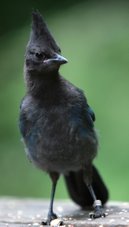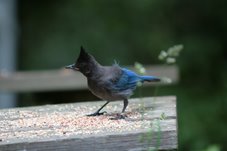NOTES
Saturday, September 29, 2007
Saturday, 8:07 am
crisp, sunny morning
Birds:
mwbw
rrmo
unbanded--left leg especially swollen
unbanded juvenile
plbmp
wwmlb
mlbrg
unbanded with leg mites, especially swollen right back toe
Finally returning to my observations. I'm in the habit of feeding the birds in the afternoon now, the morning comes so quickly on a back-to-school schedule, and my resident pair aren't here yet. Arriving first are mwbw, rrmo and one unbanded bird--clearing the peanuts out, not taking time to crack nuts and eat. Mwbw gives the male cheep cheep cheep call, though it doesn't seem that anyone is around to listen but his mate. She spends much more time shopping for nuts than she did in July. She appears more confident. Rather than perching skittishly on a limb, and swooping in quickly for a peanut, she selects first one, then another, until she finds just the right peanut.
The pair is joined by plbmp and Shopper (mwbw), mlbrg, and some unbanded birds with leg mites. As usual I'm mystified trying to distinguish whether or not mlbrg has a partner.
At 9:00, there is still no sign of the resident pair.
crisp, sunny morning
Birds:
mwbw
rrmo
unbanded--left leg especially swollen
unbanded juvenile
plbmp
wwmlb
mlbrg
unbanded with leg mites, especially swollen right back toe
Finally returning to my observations. I'm in the habit of feeding the birds in the afternoon now, the morning comes so quickly on a back-to-school schedule, and my resident pair aren't here yet. Arriving first are mwbw, rrmo and one unbanded bird--clearing the peanuts out, not taking time to crack nuts and eat. Mwbw gives the male cheep cheep cheep call, though it doesn't seem that anyone is around to listen but his mate. She spends much more time shopping for nuts than she did in July. She appears more confident. Rather than perching skittishly on a limb, and swooping in quickly for a peanut, she selects first one, then another, until she finds just the right peanut.
The pair is joined by plbmp and Shopper (mwbw), mlbrg, and some unbanded birds with leg mites. As usual I'm mystified trying to distinguish whether or not mlbrg has a partner.
At 9:00, there is still no sign of the resident pair.
Friday, July 27, 2007
Sky white still
Birds:
1. morlb (Red Eye)
2. mwrg (Wringer)
3. mgrr (Droopy)
4. mrgo (Mr. Go)
5. plbmp (Princesa)
6. unbanded (Shopper)
7. unbanded ( Rusty Bill)
8. unbanded juveniles x 2
9. mwbw (Checkers)
10. mlbbb
11. mlbrg (Trapper)
12. molbo (Mrs. Tame Bird)
13. banded juvenile (metal)
14. banded juvenile (red)
Molbo is back. She hasn’t been here since I started making a bird list each day. My thought is that she’s been sitting on a nest. She made several morning visits to the feeder, in and out. A new juvenile arrived today with red tape around its band. Pia told me it had been banded at the Secret Garden feeder on the HSU campus. Juveniles banded by Jeff Black have brown tape around the band, those banded at Jeff Jacobsen’s have a blue tape around the metal band and, those banded here are plain metal.
Birds:
1. morlb (Red Eye)
2. mwrg (Wringer)
3. mgrr (Droopy)
4. mrgo (Mr. Go)
5. plbmp (Princesa)
6. unbanded (Shopper)
7. unbanded ( Rusty Bill)
8. unbanded juveniles x 2
9. mwbw (Checkers)
10. mlbbb
11. mlbrg (Trapper)
12. molbo (Mrs. Tame Bird)
13. banded juvenile (metal)
14. banded juvenile (red)
Molbo is back. She hasn’t been here since I started making a bird list each day. My thought is that she’s been sitting on a nest. She made several morning visits to the feeder, in and out. A new juvenile arrived today with red tape around its band. Pia told me it had been banded at the Secret Garden feeder on the HSU campus. Juveniles banded by Jeff Black have brown tape around the band, those banded at Jeff Jacobsen’s have a blue tape around the metal band and, those banded here are plain metal.
Wednesday, July 25, 2007
Birds:
1. mwbw (Checkers)
2. mwlblb (Tame Bird)
3. mlbob (Mrs. Go)
4. mrgo (Mr. Go)
5. unbanded (Shopper)
6. mbow (Bow)
7. mgrr (Droopy)
8. unbanded juvenile—going in trap
9. morlb (Red Eye)
10. mwrg (Wringer)
11. banded juvenile
12. mlbrg
13. unbanded with leg mites
Notes:
I’m having trouble keeping track of all the unbanded adult birds here today. Shopper, with his sleeked back crest is easy to identify, as is unbanded with leg mites. His elbows are pink when he bends over, and his legs are swollen where they join his toes. This bird appears small and I suspect may be last year’s juvenile. There is another unbanded bird, quite large, who feeds on the bench with Checkers—lbpmp rattles when he arrives. Rusty Bill may be here, but his red feathers appear to be lighter—a blonder red. The region just below the lower bill is featherless and unusually pink. Could it be another bird, or molting changes?
I’m watching lbpmp carefully. I can almost see a bulge on her right side where her other ear is, but it is completely covered with feathers.
I am getting better at noticing the age differences among the juveniles. Some are getting their blue head stripes. These birds have a long, lean-necked look, while youngsters look plumper, downier, with grayer heads. Many of the juveniles are trying to get peanuts in their gullets, but they just aren’t big enough yet.
I’m curious about Droopy. I would guess she is a male based on her behavior. She is a spunky bird among all these males. They chase her; she chases them. She holds her own and lingers, always in a visible position, always busy. Mrs. Go, the resident female, isn’t as visible, preferring to perch in a tree, higher, in a more camouflaged lookout post. She is shyer, more cautious. It makes me so interested in this idea of “boldness”—its evolutionary advantages and disadvantages.
Monday, July 23, 2007
Birds:
Notes:
Activity at the feeder has resumed with lots of visitors today. lbpmp arrived with a deep puncture wound on the left side of her head. It looks clean without any sign of blood or infection, though the edges gape and I'm surprised she is behaving normally. She is flying, feeding, and rattling as usual. My first thought was she'd been attacked by another bird, though Jeff J. suggested it could be a pellet gun injury. I will watch her carefully and have notified Pia by e-mail.
Two new birds arrived today: mlbbb, a female; and gbmg, last year's juvenile. They, like mpbw, make very quick flurries in, take time to grab only one peanut and fly straight up and out with a bound. Strangers still, they lack the bold qualities of those birds who have been around awhile.
Yesterday, Red Eye, the boldest of the bold, discovered the whole bag of peanuts inside my bedroom door. A hot muggy day, I'd left the sliding glass door open. He pecked into the plastic bag with sharp jabs of his bill until he opened a hole large enough to extract peanuts directly from the bag. He'd drop a few on the floor, take one, and then fly off. The other birds caught on quickly, feeling quite at home to hop into the room, tap the bag and steal away with nuts. This morning, birds were lined up, outside my bedroom window, eying the bag, waiting for me to get up and feed them.
- mbow
- mgrr
- lbpmp
- mwlblb
- mlbob
- morlb
- mpbw
- mwrg
- mlbrg
- mrgo
- mwbw
- unbanded: Rusty Bill
- mlbbb* female
- gbmg*
- rrmo
- unbanded juveniles (2)
- banded juvenile
Notes:
Activity at the feeder has resumed with lots of visitors today. lbpmp arrived with a deep puncture wound on the left side of her head. It looks clean without any sign of blood or infection, though the edges gape and I'm surprised she is behaving normally. She is flying, feeding, and rattling as usual. My first thought was she'd been attacked by another bird, though Jeff J. suggested it could be a pellet gun injury. I will watch her carefully and have notified Pia by e-mail.
Two new birds arrived today: mlbbb, a female; and gbmg, last year's juvenile. They, like mpbw, make very quick flurries in, take time to grab only one peanut and fly straight up and out with a bound. Strangers still, they lack the bold qualities of those birds who have been around awhile.
Yesterday, Red Eye, the boldest of the bold, discovered the whole bag of peanuts inside my bedroom door. A hot muggy day, I'd left the sliding glass door open. He pecked into the plastic bag with sharp jabs of his bill until he opened a hole large enough to extract peanuts directly from the bag. He'd drop a few on the floor, take one, and then fly off. The other birds caught on quickly, feeling quite at home to hop into the room, tap the bag and steal away with nuts. This morning, birds were lined up, outside my bedroom window, eying the bag, waiting for me to get up and feed them.
Sunday, July 22, 2007
07:05
White sky
Birds:
1. mrgo (Mr. Go)
2. mwbw (Checkers)
3. mlbob (Mrs. Go)
4. unbanded (Shopper)
5. mlbrg (Trapper) chased by mwbw
6. morlb (Red Eye)
7. mwrg (Wringer) missing middle tail feather
8. lbpmp (Princesa)
9. mpbw (Mrs. Red Eye)
10. mgrr (Droopy)
11. unbanded
12. mwlblb (Tame Bird)
07/20/07
07:32
Cloudy mixed with blue sky
Birds:
1. mwrlb (Red Eye)
2. mpbw (Mrs. Red)
3. mrgo (Mr. Go)
4. mlbrg (Trapper)
5. Shopper
6. mlbob (Mrs. Go)
7. lbpmp (Princesa)
8. mwrg (Wringer)
9. plump juvenile
10. mgrr (Droopy)
11. mwbw (Checkers)
07/19/07
06:13
White sky
Birds:
1. mrgo (Mr. Go)
2. mlbob (Mrs. Go)
3. mgrr (Droopy)
4. unbanded juvenile (begs to Droopy)
5. mwlblb (Tame Bird)
6. lbpmp (Princesa)
7. mlbrg (Trapper)
8. Shopper (Chopper)
9. morlb (Red Esye)
10. mwrg (Wringer)
11. mwbw (Checkers)
07/18/07
06:57
Blue sky with clouds—trees drenched with water after a summer rain.
Birds:
1. mlbob (Resident Female)
2. Mrgo (Resident Male)
3. unbanded juvenile
4. Shopper
Notes:
After an absence of a week, my birds have fallen out of the peanut routine. Only Mrs. Go answers my morning greeting. She sits, perched in the tree, camouflaged, waiting quietly without calling or moving. She swoops in quickly, grabs a nut, not taking time to do her usual cross-over, two peanut pick-up. She appears cautious. Her legs are the most swollen ever—in particular the left. She favors it, lifting it as she hops in a lop-sided gait. She is wet and rumpled, a feather on her back sticking up; molting has begun.
Mr. Go arrives with a squa, squa call—only 11 minutes past the time I began watching. He looks particularly sleek, and confident, standing tall, in an alert posture, hop, hop, hopping off a flat surface into a strong, flying take-off.
An unbanded juvenile sits, perched on a branch quietly. Its wings flutter rapidly, quietly, in a begging posture, as Mr. Go arrives. The bird has aged since I last saw it, the pink around its gape has filled in some, and the downy quality of its feathers has matured. It appears taller, leaner, the circumference of its neck narrowed, not so round and plump—more adolescent in its attitude. It perches, calls, squa, squa, squa and then tchoo choo choo TCHU choo choo, TCHU. It sounds immature, tentative. It wipes its bill back and forth on a tree branch, and tap taps. I wonder if this is a way of marking territory, leaving behind a scent, a bill-cleaning ritual, or has some other significance I’m unaware of. The three birds are casual, taking their time to collect peanuts, as if they have no competition and all the time in the world to feed. An hour later, only the nuclear family has come to feed, lots of peanuts are left.
Chopper is the first to arrive outside the family group. He does his usual pick up/put down routine before selecting. Mr. Go cheep cheeps, calls chooka, chooka, chooka and begins feeding on sunflower seeds. A second juvenile arrives and begs, bill open, wings fluttering, standing next to Mr. Go on the bench.
White sky
Birds:
1. mrgo (Mr. Go)
2. mwbw (Checkers)
3. mlbob (Mrs. Go)
4. unbanded (Shopper)
5. mlbrg (Trapper) chased by mwbw
6. morlb (Red Eye)
7. mwrg (Wringer) missing middle tail feather
8. lbpmp (Princesa)
9. mpbw (Mrs. Red Eye)
10. mgrr (Droopy)
11. unbanded
12. mwlblb (Tame Bird)
07/20/07
07:32
Cloudy mixed with blue sky
Birds:
1. mwrlb (Red Eye)
2. mpbw (Mrs. Red)
3. mrgo (Mr. Go)
4. mlbrg (Trapper)
5. Shopper
6. mlbob (Mrs. Go)
7. lbpmp (Princesa)
8. mwrg (Wringer)
9. plump juvenile
10. mgrr (Droopy)
11. mwbw (Checkers)
07/19/07
06:13
White sky
Birds:
1. mrgo (Mr. Go)
2. mlbob (Mrs. Go)
3. mgrr (Droopy)
4. unbanded juvenile (begs to Droopy)
5. mwlblb (Tame Bird)
6. lbpmp (Princesa)
7. mlbrg (Trapper)
8. Shopper (Chopper)
9. morlb (Red Esye)
10. mwrg (Wringer)
11. mwbw (Checkers)
07/18/07
06:57
Blue sky with clouds—trees drenched with water after a summer rain.
Birds:
1. mlbob (Resident Female)
2. Mrgo (Resident Male)
3. unbanded juvenile
4. Shopper
Notes:
After an absence of a week, my birds have fallen out of the peanut routine. Only Mrs. Go answers my morning greeting. She sits, perched in the tree, camouflaged, waiting quietly without calling or moving. She swoops in quickly, grabs a nut, not taking time to do her usual cross-over, two peanut pick-up. She appears cautious. Her legs are the most swollen ever—in particular the left. She favors it, lifting it as she hops in a lop-sided gait. She is wet and rumpled, a feather on her back sticking up; molting has begun.
Mr. Go arrives with a squa, squa call—only 11 minutes past the time I began watching. He looks particularly sleek, and confident, standing tall, in an alert posture, hop, hop, hopping off a flat surface into a strong, flying take-off.
An unbanded juvenile sits, perched on a branch quietly. Its wings flutter rapidly, quietly, in a begging posture, as Mr. Go arrives. The bird has aged since I last saw it, the pink around its gape has filled in some, and the downy quality of its feathers has matured. It appears taller, leaner, the circumference of its neck narrowed, not so round and plump—more adolescent in its attitude. It perches, calls, squa, squa, squa and then tchoo choo choo TCHU choo choo, TCHU. It sounds immature, tentative. It wipes its bill back and forth on a tree branch, and tap taps. I wonder if this is a way of marking territory, leaving behind a scent, a bill-cleaning ritual, or has some other significance I’m unaware of. The three birds are casual, taking their time to collect peanuts, as if they have no competition and all the time in the world to feed. An hour later, only the nuclear family has come to feed, lots of peanuts are left.
Chopper is the first to arrive outside the family group. He does his usual pick up/put down routine before selecting. Mr. Go cheep cheeps, calls chooka, chooka, chooka and begins feeding on sunflower seeds. A second juvenile arrives and begs, bill open, wings fluttering, standing next to Mr. Go on the bench.
Wednesday, July 18, 2007
06:57
Blue sky with clouds—trees drenched with water after a summer rain.
Birds Sighted:
1. mlbob (Resident Female)
2. Mrgo (Resident Male)
3. unbanded juvenile
4. Chopper
Notes:
After an absence of a week, my birds have fallen out of the peanut routine. Only Mrs. Go answers my morning greeting. She sits, perched in the tree, camouflaged, waiting quietly without calling or moving. She swoops in quickly, grabs a nut, not taking time to do her usual cross-over, two peanut pick-up. She appears cautious. Her legs are more swollen than ever—in particular the left. She favors it, lifting it as she hops in a lop-sided gait. She is wet and rumpled, a feather on her back sticking up; molting has begun.
Mr. Go arrives with a squa, squa call—only 11 minutes past the time I began watching. He looks particularly sleek, and confident, standing tall, in an alert posture, hop, hop, hopping off a flat surface into a sure, strong, flying take-off.
An unbanded juvenile sits, perched on a branch quietly. Its wings flutter rapidly, quietly, in a begging posture, as Mr. Go arrives. The bird has aged since I last saw it, the pink around its gape has filled in some, and the downy quality of its feathers has matured. It appears taller, leaner, the circumference of its neck narrowed, not so round and plump—more adolescent in its attitude. It perches, calls, squa, squa, squa and then tchoo choo choo TCHU choo choo, TCHU. It sounds immature, tentative, a little hoarse. It wipes its bill back and forth on a tree branch, and tap taps. I wonder if this is a way of marking territory, leaving behind a scent, a bill-cleaning ritual, or has some other significance I’m unaware of. The three birds are casual, taking their time to collect peanuts, as if they have no competition and all the time in the world to feed. An hour later, only the nuclear family has come to feed, lots of peanuts are left.
Chopper is the first to arrive outside the family group. He does his usual pick up/put down routine before selecting. Mr. Go cheep cheeps, calls chooka, chooka, chooka and begins feeding on sunflower seeds. A second juvenile arrives and begs, bill opening and closing, wings fluttering, standing next to Mr. Go on the bench.
By the end of the day, many of the usual visitors had returned. I predict the list of birds will be back to normal by tomorrow.
Blue sky with clouds—trees drenched with water after a summer rain.
Birds Sighted:
1. mlbob (Resident Female)
2. Mrgo (Resident Male)
3. unbanded juvenile
4. Chopper
Notes:
After an absence of a week, my birds have fallen out of the peanut routine. Only Mrs. Go answers my morning greeting. She sits, perched in the tree, camouflaged, waiting quietly without calling or moving. She swoops in quickly, grabs a nut, not taking time to do her usual cross-over, two peanut pick-up. She appears cautious. Her legs are more swollen than ever—in particular the left. She favors it, lifting it as she hops in a lop-sided gait. She is wet and rumpled, a feather on her back sticking up; molting has begun.
Mr. Go arrives with a squa, squa call—only 11 minutes past the time I began watching. He looks particularly sleek, and confident, standing tall, in an alert posture, hop, hop, hopping off a flat surface into a sure, strong, flying take-off.
An unbanded juvenile sits, perched on a branch quietly. Its wings flutter rapidly, quietly, in a begging posture, as Mr. Go arrives. The bird has aged since I last saw it, the pink around its gape has filled in some, and the downy quality of its feathers has matured. It appears taller, leaner, the circumference of its neck narrowed, not so round and plump—more adolescent in its attitude. It perches, calls, squa, squa, squa and then tchoo choo choo TCHU choo choo, TCHU. It sounds immature, tentative, a little hoarse. It wipes its bill back and forth on a tree branch, and tap taps. I wonder if this is a way of marking territory, leaving behind a scent, a bill-cleaning ritual, or has some other significance I’m unaware of. The three birds are casual, taking their time to collect peanuts, as if they have no competition and all the time in the world to feed. An hour later, only the nuclear family has come to feed, lots of peanuts are left.
Chopper is the first to arrive outside the family group. He does his usual pick up/put down routine before selecting. Mr. Go cheep cheeps, calls chooka, chooka, chooka and begins feeding on sunflower seeds. A second juvenile arrives and begs, bill opening and closing, wings fluttering, standing next to Mr. Go on the bench.
By the end of the day, many of the usual visitors had returned. I predict the list of birds will be back to normal by tomorrow.
Tuesday, July 10, 2007
06:43
Same old summer sky: white, still, quiet, other than hammers banging and heavy equipment whirring at the HSU Sports Complex—will construction ever end?
Birds:
1. mrgo (Mr. Go) chases Rusty Bill
2. junvenile unbanded
3. mlbob (Mrs. Go)
4. Rusty Bill
5. Shopper
6. mwob (Bow) flies northwest--missing tail feathers
7. mwrg (Wringer)
8. mwlblb (Tame Bird)
9. morlb (Red Eye)
10. mgrr (Droopy)
11. mrgw leg mites
Notes:
There’s a pair of ravens lurking this morning. They were perched on a tree I suspect may have had a nest, and have been flying around the house in big circles, squawking loudly. They are early morning and evening intruders, rarely seen or heard in the middle of the day.
The juvenile bird is still learning to open peanuts. He tried to harvest the nut from a half-opened shell, gave up, and tried another. He clutched the nut with only one foot, wrapped his spindly toes around it, while the other foot stayed free, maintaining his balance. He struggled to pierce the shell with his bill, lacking the strength and coordination of an adult. The Sibley Guide to Bird Life and Behavior says corvids (the bird family to which jays belong) hit an object only with their lower bill: “The New World jays have a special flange on the lower jaw that braces it against the skull and makes it a more effective chisel” (411).
I work to observe this specialized adaptation in action. Adult jays use their toes and bills with amazing dexterity. They wedge their food in a two-footed vise, clamp it securely with three anterior-facing toes and one posterior. In this position, they lower their bill and begin tapping. Deftly, they remove a nut from its shell, balance one half next to them, and chip away at the other half until it has splintered into pieces small enough to eat. I can see now, what appears to be an unconscious response to the environment has been learned through trial and error. The juveniles can barely use one foot to hold their shell in place, and peck lightly. They try to bite the nut, open-jawed--which serves only to catapult it forward, out of reach. With persistence, they successfully open the nut, and swallow the half whole—a move that makes my gullet ache to watch. As time goes on, they increase their control and maneuverability, taking time to chisel the half-peanut into reasonably bite-sized pieces.
The juveniles are still learning what is food. I watched an unbanded juvenile pick up bits of lichen, moss, and leaves placing each gingerly on a branch in front of him--a delicate earth sculpture that would go unnoticed unless you happened to be there during its construction. They peck and play, experimenting, getting to know and understand their world, in the same way a one-year-old toddles around, placing everything she sees in her mouth.
Same old summer sky: white, still, quiet, other than hammers banging and heavy equipment whirring at the HSU Sports Complex—will construction ever end?
Birds:
1. mrgo (Mr. Go) chases Rusty Bill
2. junvenile unbanded
3. mlbob (Mrs. Go)
4. Rusty Bill
5. Shopper
6. mwob (Bow) flies northwest--missing tail feathers
7. mwrg (Wringer)
8. mwlblb (Tame Bird)
9. morlb (Red Eye)
10. mgrr (Droopy)
11. mrgw leg mites
Notes:
There’s a pair of ravens lurking this morning. They were perched on a tree I suspect may have had a nest, and have been flying around the house in big circles, squawking loudly. They are early morning and evening intruders, rarely seen or heard in the middle of the day.
The juvenile bird is still learning to open peanuts. He tried to harvest the nut from a half-opened shell, gave up, and tried another. He clutched the nut with only one foot, wrapped his spindly toes around it, while the other foot stayed free, maintaining his balance. He struggled to pierce the shell with his bill, lacking the strength and coordination of an adult. The Sibley Guide to Bird Life and Behavior says corvids (the bird family to which jays belong) hit an object only with their lower bill: “The New World jays have a special flange on the lower jaw that braces it against the skull and makes it a more effective chisel” (411).
I work to observe this specialized adaptation in action. Adult jays use their toes and bills with amazing dexterity. They wedge their food in a two-footed vise, clamp it securely with three anterior-facing toes and one posterior. In this position, they lower their bill and begin tapping. Deftly, they remove a nut from its shell, balance one half next to them, and chip away at the other half until it has splintered into pieces small enough to eat. I can see now, what appears to be an unconscious response to the environment has been learned through trial and error. The juveniles can barely use one foot to hold their shell in place, and peck lightly. They try to bite the nut, open-jawed--which serves only to catapult it forward, out of reach. With persistence, they successfully open the nut, and swallow the half whole—a move that makes my gullet ache to watch. As time goes on, they increase their control and maneuverability, taking time to chisel the half-peanut into reasonably bite-sized pieces.
The juveniles are still learning what is food. I watched an unbanded juvenile pick up bits of lichen, moss, and leaves placing each gingerly on a branch in front of him--a delicate earth sculpture that would go unnoticed unless you happened to be there during its construction. They peck and play, experimenting, getting to know and understand their world, in the same way a one-year-old toddles around, placing everything she sees in her mouth.
Subscribe to:
Comments (Atom)
Pia Sets the Trap

07/24/07
Peaking...

07/24/07
Oops, wrong bird!

Demonstrating the "hold"
Try Again

Bird in the Bag
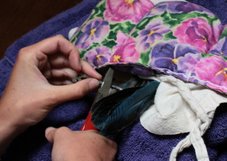
Applying a metal band
Measuring
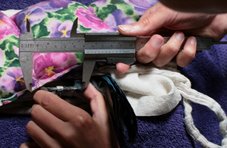
and more measuring. . . .
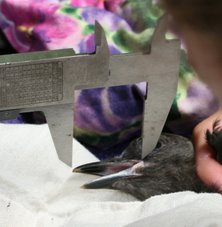
Blood Sampling

Jeff J's Work

Pia's test tube holder
Weighing
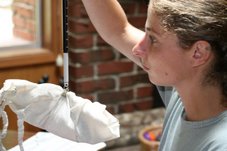
And then....release
When the sun goes down...

Steller's Jay Taxonomy/Description
Common Name: Steller's Jay
Class: Aves
Order: Passeriformes
Family: Corvidae
Genus: Cyanocitta
Species: Cyanocitta stelleri
Steller’s jay belongs to the family, Corvidae, in the Avian Order Passeriformes. Passeriformes is the order of perching birds. Corvidae is the jay, magpie and crow family. The Steller's jay's scientific name is Cyanocitta stelleri. The generic name, cyanocitta, means "blue jay". Its specific name, stelleri, named for George W. Steller (1709-1746). Steller was a German zoologist who explored the coastal areas of the northern Pacific Ocean in 1740.
Band Colors
black | white | purple | red | orangeBands are read in the following order:
light blue and light blue | green
Note: Light blue is difficult to read. It darkens with age, resembling a green band. (b/w/p/r/o/lb/g)
right bottom band
right top band
left bottom band
left top band
Data Collecting
This information was copied from the website of Dr. Jeff Black, Humboldt State University Wildlife Department.
The data to include for each record:
- Bird’s color code
- Size of social group seen at the same time
- Associates’ color codes (or if unbanded = UNB; or not determined = NOTD)
- Number of times associates came within 3 meters of each other
- Approximate time spent within 3 meter distance (e.g. 2 seconds, 15 sec, etc.)
- Total time you watched the birds (e.g. 5 minutes, 10 min, etc.)
- Time of day; start of observation (e.g. 1935)
- Date (e.g. 9.30.99)
- Location of observation (e.g. Rewood Bowl SW corner west bleachers. And state whether the bird was seen at a birdfeeder or in trees, etc)
- Comments (e.g. deformed leg, feather tuft on back, etc.)
Arcata Steller's Jay Sightings
Mr. Go










